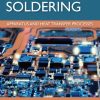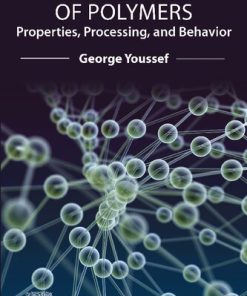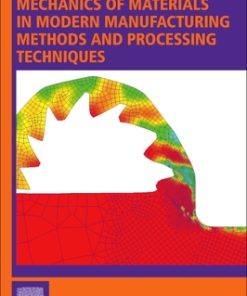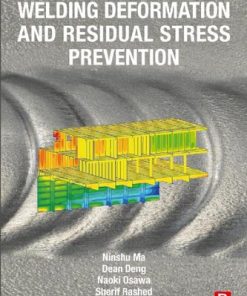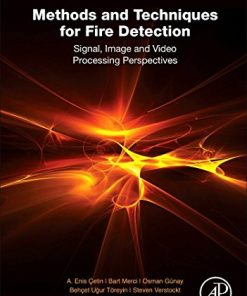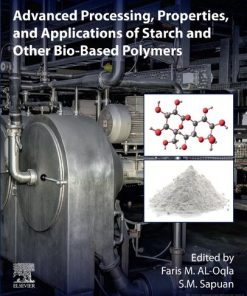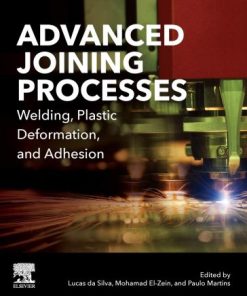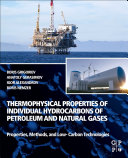Severe Plastic Deformation Methods Processing and Properties 1st edition by Ghader Faraji, Kim, Hessam Torabzadeh Kashi 0128135670 9780128135679
$50.00 Original price was: $50.00.$25.00Current price is: $25.00.
Severe Plastic Deformation: Methods, Processing and Properties 1st edition by Ghader Faraji, H.S. Kim, Hessam Torabzadeh Kashi – Ebook PDF Instant Download/DeliveryISBN: 0128135670, 9780128135679
Full download Severe Plastic Deformation: Methods, Processing and Properties 1st edition after payment.

Product details:
ISBN-10 : 0128135670
ISBN-13 : 9780128135679
Author : Ghader Faraji, H.S. Kim, Hessam Torabzadeh Kashi
Severe Plastic Deformation: Methods, Processing and Properties examines all severe plastic deformation techniques developed over the past two decades, exploring the appropriate severe plastic deformation method for a particular case. The book offers an overview of these methods, introduces ultrafine-grained and nano-grained metals and methods for various bulk, sheet, tubular and large size samples, reviews effective parameters to make a severe plastic deformation method better, from property (mechanical) and processing (cost, time, load, etc.) viewpoints, discusses mechanical, physical and chemical properties of UFG and NS metals, and concludes with various applications for these methods.
Severe Plastic Deformation: Methods, Processing and Properties 1st Table of contents:
I.1 The Ultrafine-Grained and Nanostructured Materials
I.2 First Approach: Bottom-Up
I.2.1 Inert Gas Condensation
I.2.2 Spray Conversion Processing
I.2.3 Chemical Vapor Condensation
I.3 Top-Down Methods
I.3.1 High-Energy Ball Milling
I.3.2 Physical Vapor Deposition
I.3.3 Sputtering
I.3.4 Severe Plastic Deformation Methods
References
1 Fundamentals of Severe Plastic Deformation
1.1 Introduction
1.2 History
1.2.1 The Ancient Age
1.2.2 The Scientific Age
1.2.3 The Microstructural Age
1.3 Basic Principles of Severe Plastic Deformation Methods
1.4 Difference Between Severe Plastic Deformation and Conventional Metal-Forming Processes
1.5 Grain Refinement Mechanisms Under Severe Plastic Deformation Conditions
1.5.1 Face-Centered Cubic (fcc) Metals
1.5.2 Hexagonal Close-Packed (hcp) Metals
References
2 Severe Plastic Deformation Methods for Bulk Samples
2.1 Introduction
2.2 High-Pressure Torsion
2.2.1 Incremental High-Pressure Torsion
2.2.2 Single-Task Incremental High-Pressure Torsion
2.2.3 High-Pressure Torsion Extrusion
2.3 Equal-Channel Angular Pressing
2.3.1 Conventional ECAP
2.3.2 Rotary-Die
2.3.3 Side Extrusion
2.3.4 Multipass Die
2.3.5 Torsional-Equal Channel Angular Pressing
2.3.6 ECAP With Back Pressure
2.3.7 Expansion ECAP
2.3.8 ECAP With Parallel Channels
2.3.9 ECAP With Chocked Exit Channels
2.3.10 The Different Die Designs
2.4 Dual Equal Channel Lateral Extrusion
2.5 Channel Angular Pressing With Converging Billets
2.6 Nonequal Channel Angular Pressing
2.7 Torsion Extrusion
2.8 Multiple Direct Extrusion
2.9 Accumulated Extrusion
2.10 Pure Shear Extrusion
2.11 Equal Channel Forward Extrusion
2.12 C-Shape Equal Channel Reciprocating Extrusion
2.13 Twist Extrusion
2.13.1 Elliptical Cross-Section Spiral Equal Channel Extrusion
2.13.2 Planar Twist Extrusion
2.13.3 Axisymmetric Forward Spiral Extrusion
2.14 Multidirectional Forging
2.14.1 Cyclic Closed Die Forging
2.15 Multiaxial Incremental Forging and Shearing
2.16 Repetitive Forging
2.17 Repetitive Upsetting
2.18 Cylinder Covered Compression
2.19 Repetitive Upsetting and Extrusion
2.20 Cyclic Extrusion–Compression
2.21 Cyclic Expansion–Extrusion
2.22 Accumulative Back Extrusion
2.23 Cyclic Forward–Backward Extrusion
2.24 Half-Channel Angular Extrusion
2.25 Accumulative Channel-Die Compression Bonding
2.26 Machining
2.27 The Combined Methods
2.27.1 Integrated ECAP/Extrusion
2.27.2 Twist Channel Angular Pressing
2.27.3 Twist Channel Multiangular Pressing
2.27.4 Cyclic Extrusion Compression Angular Pressing
References
3 Severe Plastic Deformation Methods for Sheets
3.1 Introduction
3.2 Accumulative Roll-Bonding (ARB)
3.3 Cone–Cone Method (CCM)
3.4 Constrained Groove Pressing (CGP)
3.4.1 Semiconstrained Groove Pressing (SCGP)
3.4.2 Rubber Pad-Constrained Groove Pressing (RP-CGP)
3.4.3 Constrained Groove Rolling (CGR)
3.5 Friction Stir Processing (FSP)
3.6 Equal Channel Angular Rolling (ECAR)
3.7 Repetitive Corrugation and Straightening (RCS)
3.8 Repetitive Corrugation and Straightening by Rolling (RCSR)
3.9 Asymmetric Rolling
3.10 Continuous Frictional Angular Extrusion (CFAE)
3.11 Continuous Cyclic Bending (CCB)
References
4 Severe Plastic Deformation Methods for Tubular Samples
4.1 Introduction
4.2 Equal Channel Angular Pressing for Hollow Parts
4.3 High-Pressure Tube Twisting
4.4 Tube High-Pressure Shearing
4.5 Modified High-Pressure Tube Twisting
4.6 Accumulative Spin Bonding
4.7 Tubular Channel Angular Pressing
4.8 Parallel Tubular Channel Angular Pressing
4.9 Combined PTCAP
4.10 Tube Channel Pressing
4.11 Cyclic Flaring and Sinking
4.12 Tube Cyclic Extrusion–Compression
4.13 Tube Cyclic Expansion–Extrusion
4.14 Rubber Pad Tube Straining
4.15 Other Combined Methods
4.16 General Limitations of UFG Tube Manufacturing Methods
References
5 Severe Plastic Deformation for Industrial Applications
5.1 Introduction
5.2 Integrated Extrusion and Equal Channel Angular Pressing
5.3 ECAP–Conform
5.4 Equal Channel Angular Drawing
5.5 ECAP With Rolls
5.6 Incremental ECAP
5.7 Porthole-Equal Channel Angular Pressing
5.8 Continuous Confined Strip Shearing
5.9 Conshearing
5.10 Continuous Cyclic Bending
5.11 Caliber Rolling
5.12 Ring High-Pressure Torsion
5.13 High-Pressure Sliding
5.14 Continuous High-Pressure Torsion
5.15 Severe Torsion Straining
5.16 Integrating Forward Extrusion and Torsion Deformation
5.17 KoBo Process
5.18 Cryo-Rolling
References
6 Effective Parameters for the Success of Severe Plastic Deformation Methods
6.1 Introduction
6.2 Grain Size
6.2.1 Equivalent Plastic Strain and Hydrostatic Stress
6.3 Dislocations and Disclinations
6.4 Grain Boundaries
6.4.1 Low- and High-Angle Boundaries
6.4.2 Equilibrium and Nonequilibrium Boundaries
6.5 Multiphase Materials
6.6 Texture
6.7 Conclusions
References
7 Mechanical Properties of Ultrafine-Grained and Nanostructured Metals
7.1 Introduction
7.2 Superior Strength and Ductility
7.3 Mechanical Anisotropy
7.4 Young’s Modulus
7.5 Fracture Toughness
7.6 Hardness
7.7 Fatigue Properties
7.7.1 LCF Resistance
7.7.2 HCF Resistance
7.8 Wear Resistance
7.8.1 Wear Resistance of UFG Al Alloys
7.8.2 Wear Resistance of UFG Copper Alloys
7.8.3 Wear Resistance of UFG/NG Titanium and Its Alloys
References
8 Physical, Chemical, and Functional Properties of UFG and NS Metals
8.1 Electrical Conductivity
8.2 Thermal Conductivity
8.3 Thermal Stability
8.4 Thermoelectricity
8.5 Hydrogen Storage Capability
8.6 Magnetic Properties
8.7 Corrosion
8.8 Biocorrosion
8.9 Biocompatibility
8.10 Cryogenic Properties
References
9 Applications of Ultrafine-Grained and Nanograined Metals
9.1 Biomedical
9.1.1 Titanium Implants
9.1.2 Biodegradable Mg Implants
9.2 Structural Examples
9.3 Hydrogen Storage Capacity of Nanostructured Mg Alloys
9.4 Sputtering Targets for the Semiconductor Industry
9.5 Superplastic Properties
9.6 Military Applications
9.7 Sport
9.8 Microforming
9.9 Nanostructured Magnets
9.10 Nanostructured Al and Cu Alloys With High Conductivity and Strength
9.11 UFG Metals for Semisolid Forming
People also search for Severe Plastic Deformation: Methods, Processing and Properties 1st:
surface severe plastic deformation
nanomaterials by severe plastic deformation
saturation of fragmentation during severe plastic deformation
severe plastic deformation (spd)
severe plastic deformation ppt
Tags:
Severe Plastic,Deformation,Methods,Processing,Properties,Ghader Faraji,Kim,Hessam Torabzadeh Kashi
You may also like…
Engineering - Industrial Engineering & Materials Science
Welding Deformation and Residual Stress Prevention 2nd edition Ninshu Ma
Engineering
Advanced Processing, Properties, and Applications of Starch and Other Bio-based Polymers 1st Edition
Medicine
Anthocyanins in Subtropical Fruits Chemical Properties, Processing, and Health Benefits 1st edition



